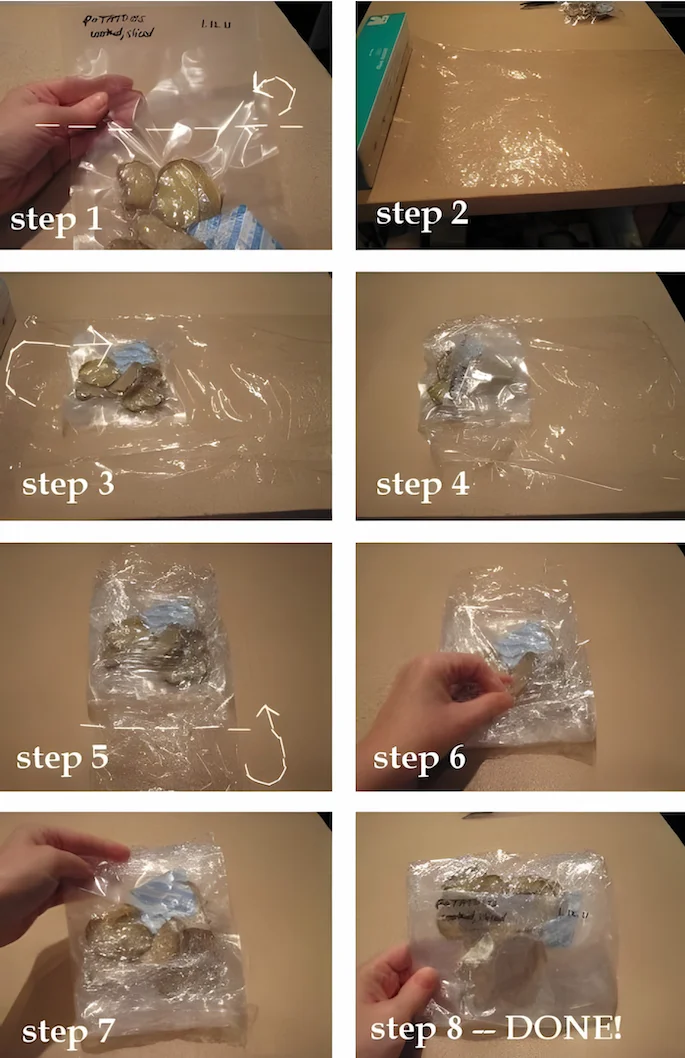Fold Excess Bag Underneath
Tuck the extra vacuum-bag top under the packet to create a smooth, flat edge.
Here at Easy Food Dehydrating, “dehydrate” always means using an electric food dehydrator — the easy, reliable way to dry food at home.

A Quick Pictorial
When you store dehydrated food, those sharp corners and brittle pieces can poke right through vacuum bags. That’s where plastic wrap comes in—it cushions hard edges and adds an extra layer of protection.
✅ Quick Answer: What is a plastic wrap guide for food storage?
A plastic wrap guide shows you how to wrap vacuum-sealed dehydrated foods in cling film to prevent punctures, protect other bags inside Mylar storage, and extend long-term freshness. It’s a simple, low-cost step that saves food from damage.
Think of it as armor for your vacuum-sealed packets. Wrapped bundles won’t damage neighboring bags inside your Mylar storage, and the food stays safe for the long haul.
When you have dehydrated your food, it can become brittle and pretty sharp. Just give a quick tap on any of your dehydrated food bags after vacuum-sealing. You'll see that they're pretty hard, right?
TIP: Always use good quality food vacuum sealer bags. Check out the Amazon suppliers link(s) on the vacuum bags'
page at Amazon.
We do the plastic wrapping to prevent the dehydrated food packets from puncturing the bag that's next to it inside the Mylar bag. Follow the pictorial guide, coming up!

Tuck the extra vacuum-bag top under the packet to create a smooth, flat edge.
Pull out ~2 feet of plastic wrap. Position the folded edge toward the torn wrap edge (on your left).
Bring the front edge of the wrap up and over the packet to start the first seal.
Roll the packet to the right, letting the wrap snugly follow and smooth out air pockets.
Fold in the side flaps (the “wings”) along the dotted-line area for a neat, padded edge.
Fold the bottom section up and across the back of the packet to lock the sides.
Now fold the top flap down to complete the cushioned, puncture-resistant bundle.
Turn the packet over so your handwritten label shows clearly through the wrap.
Some dehydrated fruit and vegetables may need this optional protection—and it's easy to do—as shown in the eight photographs.
TIP: When you have taken out a packet of dehydrated food to use, don't throw away the plastic wrap!
Instead, wrap it around an old cardboard paper-towel roll tube or fold the plastic wrap gently—and USE IT AGAIN!
Fold back about 1/2" of it from the edge so you can use it as a "tab" ... no more picking at the edge to FIND the edge! I do the same thing for scotch-tape!
Why should I wrap vacuum-sealed food in plastic wrap?
Wrapping cushions sharp edges so they don’t puncture neighboring bags inside Mylar storage. It’s optional but strongly recommended for brittle or pointy foods.
Can I reuse the plastic wrap after opening food?
Yes—fold it gently or roll it onto a cardboard tube for easy reuse. Add a folded “tab” so you never struggle to find the edge.
Does plastic wrap affect the vacuum seal or freshness?
No. The wrap goes on after vacuum sealing, so it won’t interfere with the seal or the oxygen absorber and desiccant packets.
Do I need to wrap every type of dehydrated food?
Not always. But foods like jerky, carrots, beets, or root veggies often have sharp corners that benefit from extra protection.
What kind of plastic wrap works best for food storage?
A sturdy, BPA-free cling film with a slide cutter makes wrapping quick and easy. Look for microwave-safe options that are tear-resistant.
Protecting your dehydrated food with plastic wrap is a small step that makes a big difference—keeping sharp edges from ruining your storage efforts.
Once you’ve got your meals safely wrapped and tucked away, why not treat yourself to my free 5 Dried Food Recipes You'll Actually Love PDF? Inside you’ll find cozy carrot soup, hearty minestrone, classic split pea, spicy beef jerky, and even sweet banana cinnamon rolls. Download it below and enjoy!
Here's where you can get your copy of our all new
5 Dried Food Recipes (That Actually Taste Great)
They're my all-time favorite easy dried food meals!
Get it here right now.
For Free!
If you enjoyed this page, tap the ❤️ in the lower right-hand corner.
It saves this page to your Grow bookmarks so you can find it again later.
You’ll also see quick share buttons to copy the link, post to Facebook,
or save it straight to Pinterest.